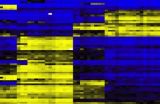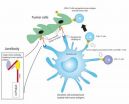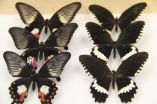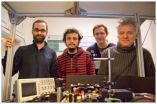(Press-News.org) ROVIDENCE, R.I. [Brown University] — When a person becomes sick or is exposed to an unwelcome substance, the body mobilizes specific proportions of different immune cells in the blood. Methods of discovering and detecting those profiles are therefore useful both clinically and in research. In a new paper in the journal Genome Biology, a team of scientists describes a new and uniquely advantageous way to detect them.
All the current means of counting immune cells in a blood sample require whole cells, said Karl Kelsey, professor of epidemiology at Brown and corresponding author, but the new system relies on something far less ephemeral: DNA. Its use of hardy strands of genetic material allows it to handle even archived samples where cells have lost their physical integrity.
All of a person's immune cells — in fact, nearly all of their cells — have exactly the same DNA, but what makes a kidney cell different from a brain cell or a T-cell distinct from a B-cell are chemical alterations known as epigenetic marks. Those cause a cell's genes to be expressed in the particular way that makes them different. One type of those alterations is methylation, and every kind of cell has its own methylation signature.
"Once you understand the unique and really immutable signature that directs the differentiation of the cell, then you can use that and you don't need the cell anymore," Kelsey said.
So the new test detects those methylation signatures in a blood sample and, with the help of sophisticated algorithms, counts up how many cells of each type are in the sample. In the experiments reported in the paper, Kelsey, lead author William Accomando, and colleagues counted up the following major immune cell types, or leukocytes: T-cells, B-cells, NK cells, monocytes, eosinophils, basophils, and neutrophils.
Based on their tests using fresh human blood samples from more than 80 donors, they report that their technique's accuracy performed at par in a direct comparison with three "gold standard" methods: "manual five-part differential," "CBC with automated five-part differential," and "fluorescence activated cell sorting."
In further experiments they showed that their technique works to detect the mixtures of immune cells associated with known diseases and that the technique works with blood exposed to storage conditions such as freezing and the addition of anticoagulants.
Moreover, in their experiments the team showed that to distinguish among and count those various immune cell types, they only needed to measure a few dozen methylation marks in the DNA. What's sufficient to constitute a signature, in other words, can be quite short.
The main ingredients of the method, Kelsey said, are libraries of methylation signatures of cells. Kelsey's lab determined the ones needed for this study, but big new epigenetics research consortia in Europe and the United States are poised to produce many more, greatly expanding the versatility of the proprietary method to cover more immune cells and other cell types as well.
In addition to the algorithms and the libraries, the test also requires some hardware, such as commercially available methylation microarrays.
The method has proven feasible enough that many other epidemiology research labs are already using it, Kelsey said. Brown University has also applied for a patent on the technique. He said it has the potential to be cheaper and faster than current techniques, although he didn't measure that in the paper.
INFORMATION:In addition to Kelsey and Accomando, the paper's other authors are John Wiencke of the University of California–San Francisco, E. Andres Houseman of Oregon State University, and Heather Nelson of the University of Minnesota.
The researchers have made their microarray data available on NCBI's Gene Expression Omnibus.
The work was supported by a gift from the Johnson & Johnson Corporate Office of Science and Technology and by grants from the National Institutes of Health (R01CA126831, R01CA52689, R01CA126939, R01CA121147, R01CA100679, R01CA078609, R01ES06717, R01MH094609, and T32CA09001).
An inventive new way to profile immune cells in blood
2014-03-05
ELSE PRESS RELEASES FROM THIS DATE:
Novel cancer vaccine holds promise against ovarian cancer, mesothelioma
2014-03-05
A novel approach to cancer immunotherapy – strategies designed to induce the immune system to attack cancer cells – may provide a new and cost-effective weapon against some of the most deadly tumors, including ovarian cancer and mesothelioma. Investigators from the Massachusetts General Hospital (MGH) Vaccine and Immunotherapy Center report in the Journal of Hematology & Oncology that a protein engineered to combine a molecule targeting a tumor-cell-surface antigen with another protein that stimulates several immune functions prolonged survival in animal models of both ...
Hungry for 'likes': Frequent Facebook use linked to eating disorder risk, study finds
2014-03-05
TALLAHASSEE, Fla. — Frequent Facebook users might be sharing more than party pictures, vacation videos and shameless selfies — they also share a greater risk of eating disorders, according to a new study led by Florida State University researchers.
Psychology Professor Pamela K. Keel studied 960 college women and found that more time on Facebook was associated with higher levels of disordered eating. Women who placed greater importance on receiving comments and "likes" on their status updates and were more likely to untag photos of themselves and compare their own photos ...
Prenatal nicotine exposure may lead to ADHD in future generations
2014-03-05
TALLAHASSEE, Fla. — Prenatal exposure to nicotine could manifest as attention deficit hyperactivity disorder in children born a generation later, according to a new study by Florida State University College of Medicine researchers.
Professors Pradeep G. Bhide and Jinmin Zhu have found evidence that ADHD associated with nicotine can be passed across generations. In other words, your child's ADHD might be an environmentally induced health condition inherited from your grandmother, who may have smoked cigarettes during pregnancy a long time ago. And the fact that you never ...
A single gene, doublesex, controls wing mimicry in butterflies
2014-03-05
A single gene regulates the complex wing patterns, colors and structures required for mimicry in swallowtail butterflies, report scientists from the University of Chicago, March 5 in Nature. Surprisingly, the gene described, doublesex, is already well-known for its critical role in sexual differentiation in insects.
"Conventional wisdom says that it should be multiple genes working together to control the whole wing pattern of a butterfly," said Marcus Kronforst, Neubauer Family Assistant Professor of Ecology & Evolution at the University of Chicago and senior author ...
Ultra sensitive detection of radio waves with lasers
2014-03-05
Radio waves are used for many measurements and applications, for example, in communication with mobile phones, MRI scans, scientific experiments and cosmic observations. But 'noise' in the detector of the measuring instrument limits how sensitive and precise the measurements can be. Now researchers at the Niels Bohr Institute have developed a new method where they can avoid noise by means of laser light and can therefore achieve extreme precision of measurements. The results are published in the prestigious scientific journal, Nature.
'Noise' in the detector of a measuring ...
Livestock can produce food that is better for the people and the planet
2014-03-05
With one in seven humans undernourished, and with the challenges of population growth and climate change, the need for efficient food production has never been greater. Eight strategies to cut the environmental and economic costs of keeping livestock, such as cows, goats and sheep, while boosting the quantity and quality of the food produced have been outlined by an international team of scientists.
The strategies to make ruminant - cud-chewing - livestock a more sustainable part of the food supply, led by academics at the University of Bristol's School of Veterinary ...
ALS-linked gene causes disease by changing genetic material's shape
2014-03-05
Johns Hopkins researchers say they have found one way that a recently discovered genetic mutation might cause two nasty nervous system diseases. While the affected gene may build up toxic RNA and not make enough protein, the researchers report, the root of the problem seems to be snarls of defective genetic material created at the mutation site.
The research team, led by Jiou Wang, Ph.D., an assistant professor of biochemistry and molecular biology and neuroscience at the Johns Hopkins University School of Medicine, reports its finding March 5 on the journal Nature's ...
Study aims to define risk factors for falls in post-menopausal women
2014-03-05
ROSEMONT, Ill.–A new study appearing in the March issue of the Journal of Bone and Joint Surgery (JBJS) showed that women with distal radius (wrist) fractures had decreased strength compared to similar patients without fractures. This could explain why these women were more likely to fall and might sustain future fractures.
The investigators used a variety of balance and strength tests combined with patient-provided information about walking habits to evaluate the physical performance and risk of falls for post-menopausal women with and without previous wrist fractures. ...
UF researchers find drug therapy that could eventually reverse memory decline in seniors
2014-03-05
GAINESVILLE, Fla. — It may seem normal: As we age, we misplace car keys, or can't remember a name we just learned or a meal we just ordered. But University of Florida researchers say memory trouble doesn't have to be inevitable, and they've found a drug therapy that could potentially reverse this type of memory decline.
The drug can't yet be used in humans, but the researchers are pursuing compounds that could someday help the population of aging adults who don't have Alzheimer's or other dementias but still have trouble remembering day-to-day items. Their findings will ...
NASA sees Tropical Cyclone Faxai stretching out
2014-03-05
When a tropical cyclone becomes elongated it is a sign the storm is weakening. Imagery from NASA-NOAA's Suomi NPP satellite today revealed that wind shear was stretching out Tropical Cyclone Faxai and the storm was waning.
On March 5 at 1500 UTC/10 a.m. EST, Tropical Cyclone Faxai's center was located near 22.5 south and 155.2 east, about 699 nautical miles/804.4 miles/ 1,295 km west-northwest of Wake Island. According to the Joint Typhoon Warning Center or JTWC, Faxai's maximum sustained surface winds dropped to 50 knots/57.5 mph/92.6 kph. Faxai was moving to the northeast ...




